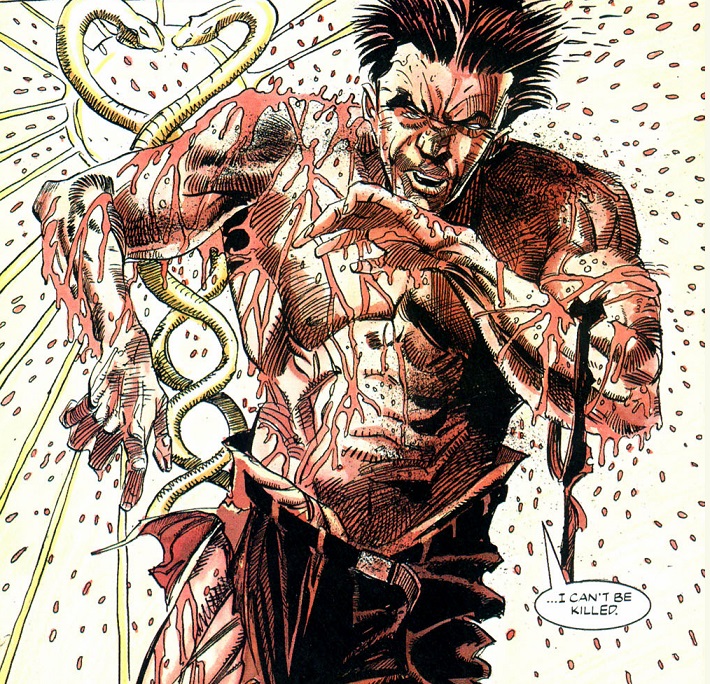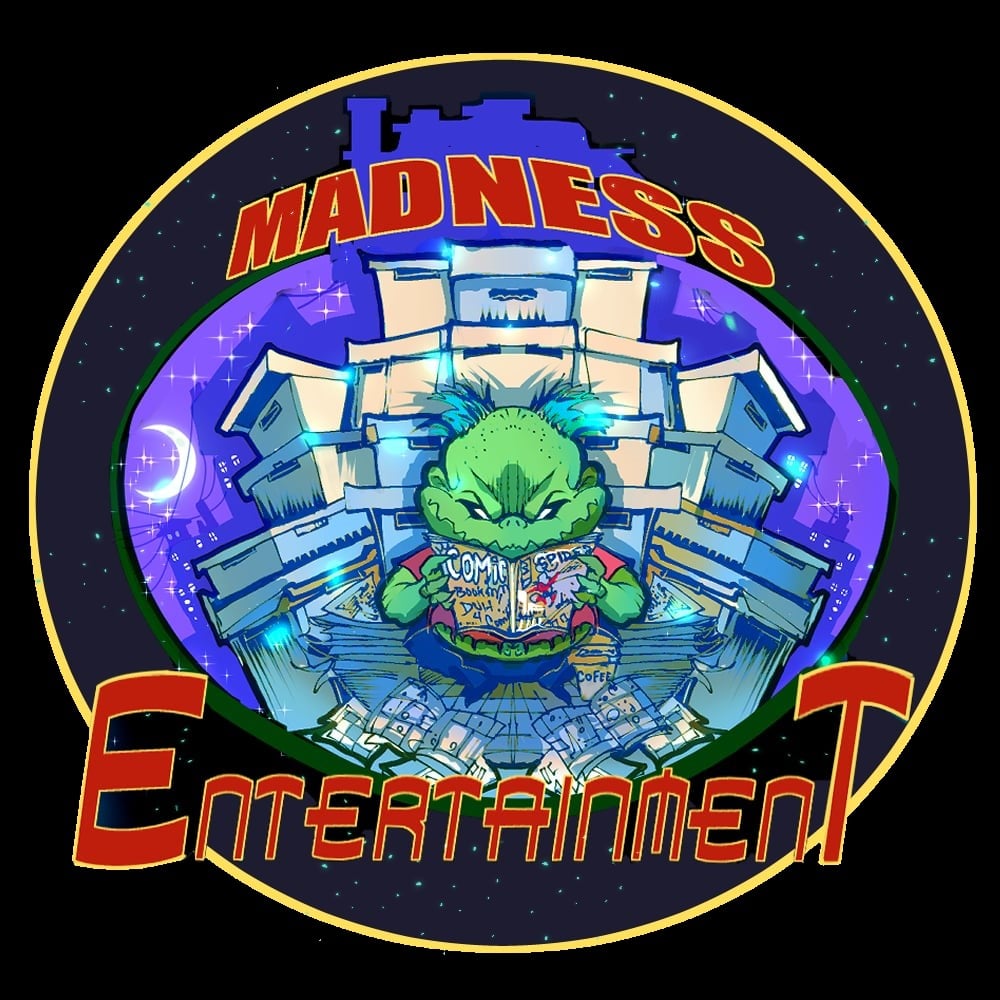Critical Depth - Milestone Media
FTC Statement: Reviewers are frequently provided by the publisher/production company with a copy of the material being reviewed.The opinions published are solely those of the respective reviewers and may not reflect the opinions of CriticalBlast.com or its management.
As an Amazon Associate, we earn from qualifying purchases. (This is a legal requirement, as apparently some sites advertise for Amazon for free. Yes, that's sarcasm.)
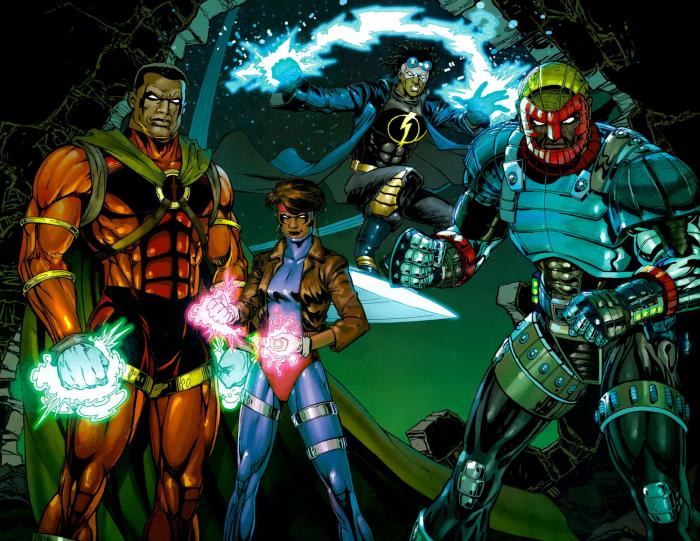
In the various reviews and columns I do for Critical Blast, I talk a lot about diversity in comics. I have said this many times over, as much as Marvel and DC seem inclined to throw out more diverse characters, the biggest problem for me continues to the need for more diversity in terms of the actual people writing, drawing, and editing comics. There has been a little more optimism in this are lately with David F. Walker wring Cyborg, G. Willow Wilson writing Ms Marvel, and renowned author Ta-Nehisi Coates being announced as the new writer of Black Panther.
But way back in 1993, there was a much more serious attempt at creating diversity in comics. And it was called Milestone Media.
Milestone was a coalition of African-American artists and writers determined to help bring some more diversity into the comic industry. Dwayne McDuffie, Denys Cowan, Michael Davis, and Derek J. Dingle were the original founders. Milestone was its own separate company. The books were published by DC, but took place in its own continuity and DC maintained very little editorial control.
One this that really impressed me about Milestones books is that they really did look as diversity as a much bigger issue that just “put more black characters in comics.” Their books dealt with a lot of big issues, including teen pregnancy, drug addiction, gangs, and pretty much everything else you can imagine. Women had a much bigger role in comics than a lot of mainstream comics at the time (though sadly, there was never a Milestone book which featured a solo female character). They also featured gay and transgendered characters. In fact, the Deathwish miniseries is pretty much entirely about a transgendered police officer and the difficulties she faced. This was over twenty years ago, and there still hasn’t been any other mainstream transgendered characters since then. Milestone was far ahead of its time.
Milestone launched with four titles: Hardware, Blood Syndicate, Icon, and Static. Later they expanded to include Xombi, Shadow Cabinet, Kobalt, Heroes, and a handful of mini-series. Milestone went out of business in 1997, though Static’s cartoon continued past then. There have been a handful of attempts to bring Milestone back, including Static getting his own book as part of DC’s New 52. I have also heard some rumblings that Milestone might be coming back soon. I would definitely like to see that happen, especially if it is done with the same vision as the original.
I actually was a fan of Milestone since day one. I came home from school one day, and my mom had been at the mall. The comic shop was doing a signing of Hardware #1 which had come out that day, and she had met Dwayne McDuffie. Sadly, I never had the chance to meet him myself, as he’s one of my favorite writers. She liked what he had to say about diversity in comics, and she ended up buying the comic for me, getting it signed. This was pre-Internet so I didn’t have any idea what Milestone was. But I thought that first issue was a terrific new take on the superhero story. I was immediately hooked. Unfortunately, I was a 14 year old kid without a lot of spending power. Milestone (like most indy books) tended to be more expensive than most other comics, so I wasn’t able to buy many of them new. I eventually did put together a Milestone collection, which I still have to this day. I re-read my favorites often. In fact, my most recent read through is what inspired this column.
One thing I never liked about Milestone was their events. Milestone seemed to be trying to do something different with their crossovers, trying to make sure you didn’t have to buy series you didn’t normally buy to get the story. But at times, that made the events feel real vague and non-consequential. More on that later.
A lot of the Milestone characters felt like homages to classic superhero stereotypes. Hardware is sort of Iron Man; Icon is Superman; Static has a lot in common with Spider-Man; and Kobalt really reminds me of Batman (even having a teen sidekick). But none of these characters feel like ripoffs. They all had a lot of unique qualities that made them stand out as something very new. And many of the books still feel very relevant today, which is rare for comics of the 90’s.
Milestone takes place in the fictional city of Dakota and the depressed neighborhood of Paris Island. Most of Milestone’s series start around the time of an event called “The Big Bang.” A massive gang war breaks out on Paris Island. Police are sent in to stop it with an experimental tear gas. But events have been manipulated, and the tear gas seems to kill or mutate everyone that is hit by it. This gives many of the gang bangers and innocent bystanders superpowers.
By keeping everything pretty confined to one city, this ensures that the characters often interacted with each other in a variety of ways. Static worked at a fast food joint under Rocket’s mom, for example. This made everything feel like one strong cohesive universe. But it was done a lot more organically than a lot of shared comic universes.
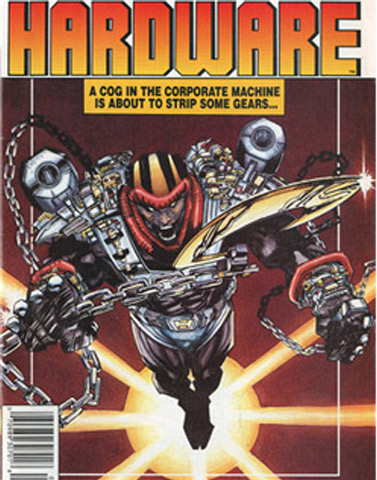 Hardware: In the 90’s, armored characters were real popular. Iron Man was pretty much in a rut for a long time, but Valiant had X-O Manowar; DC had Steel and Azrael; Marvel had Darkhawk; Image had Shadowhawk and Milestone had Hardware. Curtis "Curt" Metcalf was a genius inventor who had been groomed by Alva Industries. Curtis decides to ask Alva for a bigger stake in the company, and he quickly finds out that his mentor doesn’t seem him as anything more than a cog. Curtis builds the Hardware armor to take down Alva, especially once he realizes that Alva is in deep with many criminal enterprises. One thing that jumped out at me immediately was that Hardware wasn’t quite a hero, especially in his early issues.
Hardware: In the 90’s, armored characters were real popular. Iron Man was pretty much in a rut for a long time, but Valiant had X-O Manowar; DC had Steel and Azrael; Marvel had Darkhawk; Image had Shadowhawk and Milestone had Hardware. Curtis "Curt" Metcalf was a genius inventor who had been groomed by Alva Industries. Curtis decides to ask Alva for a bigger stake in the company, and he quickly finds out that his mentor doesn’t seem him as anything more than a cog. Curtis builds the Hardware armor to take down Alva, especially once he realizes that Alva is in deep with many criminal enterprises. One thing that jumped out at me immediately was that Hardware wasn’t quite a hero, especially in his early issues.
Hardware was the first Milestone comic, and it was basically the last one standing before the company shut its doors in 1997. To me, that spoke strongly about how important this character was to Milestone and comics on a whole. I get that Static probably has more mainstream appeal because of the cartoon, but I actually think Hardware should be pushed more heavily as the face of Milestone. In fact, in the Static: Rebirth of the Cool mini-series, the highlight of that series for me was that Hardware returns too. If there are plans to bring back Milestone, I humbly suggest that the first title should be Hardware.
![]() Icon: During the 1800’s, an alien ship is attacked and crashes on Earth. As a defense mechanism, the ship’s passenger is changed to resemble the first person who finds the ship. This happened to be a slave, so the alien is turned into a black baby. This child is raised as a slave, even though he secretly has super powers. Augustus Freeman has seen a lot in his long life, but when he encounters a young woman named Raquel in the 1990’s, she insists that he could do a lot more to help people than just being a corporate lawyer. He becomes Icon, and she becomes his sidekick, Rocket.
Icon: During the 1800’s, an alien ship is attacked and crashes on Earth. As a defense mechanism, the ship’s passenger is changed to resemble the first person who finds the ship. This happened to be a slave, so the alien is turned into a black baby. This child is raised as a slave, even though he secretly has super powers. Augustus Freeman has seen a lot in his long life, but when he encounters a young woman named Raquel in the 1990’s, she insists that he could do a lot more to help people than just being a corporate lawyer. He becomes Icon, and she becomes his sidekick, Rocket.
Icon was a very unique character in Milestone. He comes from means and at first, he looked down on poor black characters believing they should pull themselves out of poverty by their bootstraps. This was a real shock to the system. Most black fictional characters fall into certain stereotypes, but Augustus had a strong separate voice. This fell strongly in line with Milestone’s diversity. Not all black people have the same experience. Icon’s perspective matters just as much as everyone else’s
I also liked Rocket a lot. Raquel finds out that she’s pregnant pretty early into the series. The challenges facing a young, single, pregnant black women are something you’ve never seen dealt with in a comic before. Icon, like Hardware, has a lot of complexity to it, and I think it holds up real strong to this day. There have been a lot of Superman homages over the years, but Icon stands out for me. I also loved that Icon and Rocket showed up in the Young Justice cartoon, though they really didn’t get much of a chance to show their personality there. I always hoped that exposure would bring them back to the comics.
By the way, the last issue of Icon is one of my all-time favorite comics. Rocket’s grandmother passes away, and this issue really shows what it’s like when you lose someone. That sadness, but still the fond remembrance as you sit around and tell stories about that person’s life. I also loved seeing Static babysitting Raquel’s kid. I don’t think I’ve seen any fiction in any media that was able to convey the reality of a loss like Icon #42.
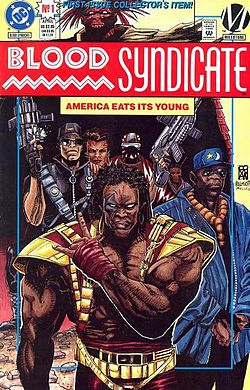 Blood Syndicate – While it is easy to see where the other launch Milestone series came from, Blood Syndicate is a different animal entirely. Blood Syndicate are all “Bang babies” representing the various gangs that fought in The Big Bang. They have set up a tight treaty to keep the peace and work to protect Paris Island. This isn’t like any other superhero team I’ve ever read. They don’t fight a lot of supervillains, and most of the general public doesn’t know whether to respect them or be terrified of them. I also like that Blood Syndicate basically just gathered up members as they go. Characters like Aquamarie, Oro, and Kwai who you wouldn’t normally think of hanging out with a gang, but somehow it all worked.
Blood Syndicate – While it is easy to see where the other launch Milestone series came from, Blood Syndicate is a different animal entirely. Blood Syndicate are all “Bang babies” representing the various gangs that fought in The Big Bang. They have set up a tight treaty to keep the peace and work to protect Paris Island. This isn’t like any other superhero team I’ve ever read. They don’t fight a lot of supervillains, and most of the general public doesn’t know whether to respect them or be terrified of them. I also like that Blood Syndicate basically just gathered up members as they go. Characters like Aquamarie, Oro, and Kwai who you wouldn’t normally think of hanging out with a gang, but somehow it all worked.
Despite the constantly shifting roster, they did an excellent job giving each of the characters some spotlight. Though I will say that Blood Syndicate did sometimes feel like it was in a rut. Team robs a local crackhouse. Spends the money extravagantly. They are broke…and argue about the morality of robbing crackhouses. And the series did end a bit abruptly without a lot of closure for most of the characters. They did seem like they were going to finish telling the Blood Syndicate’s story in Icon…but then that series ended abruptly in the middle of that arc too. In fact, that was so abrupt that there actually is a next issue blurb with a cover image at the end of Icon #42. I actually spent a long time looking for Icon #43, before I found it that it never existed.
 Static: To keep him out of gang life, Virgil Hawkins’ family moved to a nice neighborhood of Dakota. But, Virgil was tired of being bullied at school, so a friend of his gave him a gun and told him that he would be able to take this bully out during the Big Bang and no one would know he did it. Virgil heads to Paris Island, and ends up getting hit with the experimental tear gas which turns him into the electric powered superhero Static. Virgil is a bit of a goofy kid, so you can’t help but make comparisons to Spider-Man, though Static’s parents are a strong influence in his life, which is a rarity with any comic character, much less a black character.
Static: To keep him out of gang life, Virgil Hawkins’ family moved to a nice neighborhood of Dakota. But, Virgil was tired of being bullied at school, so a friend of his gave him a gun and told him that he would be able to take this bully out during the Big Bang and no one would know he did it. Virgil heads to Paris Island, and ends up getting hit with the experimental tear gas which turns him into the electric powered superhero Static. Virgil is a bit of a goofy kid, so you can’t help but make comparisons to Spider-Man, though Static’s parents are a strong influence in his life, which is a rarity with any comic character, much less a black character.
Like most Milestone series, Static deals with some real serious social issues. There is a story arc called “What Little Boys are Made Of?” which deals with Static reacting to the news that one of his best friends is gay (hint: he doesn’t take it well). There is also an issue that deals with Static losing his virginity, but I will admit that story didn’t have a lot of build up or payoff, so at the end of the day, the only reason anyone even remembers that issue is because DC refused to publish the original cover which showed Virgil and Daisy making out while there was an unopened condom package on the floor.
I do have a bit of a beef to pick with Static, and I will be the first one to admit it’s a bit unfair. Static is pretty much the only Milestone character who DC seems to see any real value in, so he has appeared in TV series, the New 52, etc. There are even talks about a Static live action movie. I have no real problem with Static, but for me, Icon, Rocket, and Hardware are the Milestone characters I want to see much more of. But, Static is still a strong black teenage role model, so if any character has to be Milestone’s legacy, you could do a lot worse.
The issue 0 was just kind of there, but in the main series, they did an excellent job expanding the world of Xombi. There is a lot of mysticism and weirdness. I actually was reminded a lot of Sandman while I was reading Xombi, which is definitely a good thing. The characters were all real intricately arranged into the story. There is also a lot of real strong action and emotion. David tries to revive a friend using his nanites, and realizes that he’s too late. That scene had a huge impact on me. I really hadn’t expected much when I finally sat down to read Xombi, but it ended up being one of my favorite Milestone series.
I actually had no idea that they brought back Xombi just a few years ago. In 2011, there was a real short lived Xombi series. John Rozum even returned to write the character. I wasn’t reading comics at the time and can’t find much information about where this series even came from. I don’t know if this was part of a plan to bring back Milestone, or just a random hiccup.
Shadow Cabinet: To be honest, Shadow Cabinet is the only Milestone ongoing series I could never get in to. The Shadow Cabinet was put together by a man named Dharma who claimed that he was able to see the future. He gathered up superhumans and sent them out on missions to try and establish the perfect future. But more than anything else, he was just manipulating events to suit his own need, sacrificing his teammates and even enslaving them as he felt was needed. I actually thought the concept of Shadow Cabinet was really cool, but it just never quite felt fully realized. The characters and stories for the most part never really grabbed me. I think Shadow Cabinet was actually the first Milestone series to be cancelled, and that doesn’t surprise me at all.
Kobalt: Kobalt was launched a few years into Milestone’s run. Kobalt is about a mysterious vigilante who is gunning for a crime boss named Martin St Cloud. Meanwhile, one of Kobalt’s friends has a son who is obsessed with the idea of being a superhero. This friend is owed a favor, so he gets Kobalt to train the kid as his sidekick. Kobalt isn’t comfortable working with others, and Page is far from ideal sidekick material, especially in the beginning of the series. This dynamic works really well.
We never find out much about who Kobalt is. The series gives us a lot of hints, but the reader is forced to put it together themselves, and the series seems to end before we got all the pieces. Kobalt believed that most of his strength came from being able to operate in the shadows, since he didn’t really have any superpowers. At some point, he is filmed beating on a villain, and this puts him in a dangerous position. He ends up faking his own death. What happens to Kobalt after that is pretty unknown.
Kobalt has always been interesting to me. Most superhero comics at the time had sort of gotten away from sidekicks and non-powered vigilantes. Kobalt really felt fresh because there wasn’t a lot like it at the time.
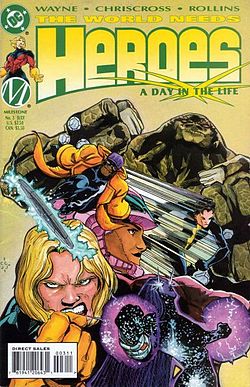 Heroes: Heroes came towards the end of Milestone’s run. After the Shadow Cabinet fell apart, several of the members decided to form a superhero team with Static. They operated out of New York (they never quite explained how Static, who was a teenage in Dakota was able to spend so much time in New York). There was a lot of cool stuff here, including the revelation that Blitzen and Donner were actually lesbians. I also liked the first real story arc which had them travelling to the microverse in search of Iota’s long lost husband, who ended up becoming a despot and was plotting an invasion of Earth.
Heroes: Heroes came towards the end of Milestone’s run. After the Shadow Cabinet fell apart, several of the members decided to form a superhero team with Static. They operated out of New York (they never quite explained how Static, who was a teenage in Dakota was able to spend so much time in New York). There was a lot of cool stuff here, including the revelation that Blitzen and Donner were actually lesbians. I also liked the first real story arc which had them travelling to the microverse in search of Iota’s long lost husband, who ended up becoming a despot and was plotting an invasion of Earth.
But unfortunately, this series only lasted six issues as Milestone was really closing up shop at this point. If they do a Milestone relaunch, I really hope that we get a lot more Heroes. Milestone had showed that they could rock the status quo using traditional stereotypes. Heroes was their first public superhero team, and I really wanted to see what they could do with that concept.
Crossovers
Shadow War: Shadow War was Milestone’s first crossover. At the time, they only had four books (Hardware, Icon, Blood Syndicate, and Static). This crossover also introduced us to Xombi and Shadow Cabinet. Over the course of the story, a splinter group from Shadow Cabinet called the Star Chamber tries to recruit heroes to fight back against Shadow Cabinet’s attempts to rule the world. In the end, we find out Star Chamber are the real bad guys, and they are trying to set off a massive genetic bomb. Hardware is able to stop them.
Shadow War worked well for the most part, though I thought it was a mistake to introduce Xombi here. He is a pretty complicated character, and Xombi 0 does not give you all that much to care about. For the longest time, I had not read Xombi just because of his poor showing here.
Long Hot Summer: Long Hot Summer starts with such a great concept. A powerful corporation decides to build a massive amusement park on Paris Island, and in the process they drive out the people who are already living there. This gentrification causes a lot of unrest, especially since the people who lived there can’t afford to go to the new park. We even get riots. There was a lot of huge potential here to tell an important story. But Long Hot Summer feels really scattered. Each Milestone book ties into it, but the stories are very separate and disconnected. Some of the stories even take place in the winter, which didn’t make a lot of sense for a series called Long Hot Summer. I think they were trying to show how long this whole process was taking, but it felt clumsily done. There are some really great moments in Long Hot Summer, like Wise Son’s speech at the end to try and get people to settle down. But on a whole, it felt like Milestone might have bit off more than they could chew here. This probably would have worked better as an arc that hit a few Milestone books that trying to shoehorn every comic and storyline here.
Worlds Collide: I have a real soft spot for cross-company crossovers. I think they are a lot of fun, and even the bad ones, I tend to find a lot that I enjoy. Worlds Collide paired the DC universe (really just the Superman books) up with the Milestone universe. It turns out there is a guy who falls asleep every night in Dakota and then wakes up in Metropolis. Once he falls asleep in Metropolis, he wakes back up in Dakota. He is experimented on by villains, and ends up becoming Rift, a cosmic baddie. Rift believes that both of these worlds are dreams, and starts to do some terrible things (including destroying all of Paris Island). The heroes of both worlds start working together to stop him.
Worlds Collide doesn’t have a lot of real depth to it, but I did love the character moments, especially Superboy, Rocket, and Static. When Superboy is trying to flirt with Rocket, and she tells him that she had a kid, the reaction is pretty perfect. I also think Worlds Collide was pretty much the first time Rocket and Static really got to interact. They would have a great friendship later on in Milestone’s run, with Rocket even getting Static to babysit for her.
And the different perspective of Hardware and Steel were really well done. Worlds Collide is one of my favorite crossover stories, and definitely worth checking out, even if it does at times feel like it’s more of a DC story than a Milestone story. The two approaches don’t quite merge seamlessly, especially when it came to Blood Syndicate, who seemed in the story just for the sake of being in the story.
Mini-series (Deathwish, My Name is Holocaust, and Wise Son: The White Wolf): What made the Milestone mini-series interesting to me is that they really seemed to be going for something a little more “artsy” and independent than you got in the normal ongoing Milestone series, especially when it comes to Deathwish and Wise Son. Honestly, I wasn’t really into these books, but I do give Milestone credit for looking to do something real different. I did think it was great that Deathwish featured a transgender character. And Holocaust gave a lot of insight into the character. But none of these books are must reads if you are trying to catch up on Milestone. And I hated that Holocaust changed his name to Pyre…glad they eventually changed it back.
Post-Milestone
Static Shock: Rebirth of the Cool (2001) - What really disappointed me about Static Shock: Rebirth of the Cool was that even though it only came out 4 years after the end of Milestone’s main line, they didn’t bother trying to tie up any of the cliffhangers that appeared at the end of the various series. This is actually a pretty good mini-series, which brings back a lot of Milestone characters in a story about Bang Babies being kidnapped and Static’s attempts to avoid being dragged back into superhero life after his ally Dusk was killed. You sort of get the sense that they were hoping to use this as a way to bring the entire line back to life, but it just didn’t get all that much press or attention, so Milestone would fade away for a pretty long time. For me, I would have rather they used these issues as a coda for the series…but that wouldn’t happen for close to 10 years…
Milestone Forever (2010) – Milestone Forever is pretty much everything I wanted Rebirth of the Cool to be. Under the framework of Shadow Cabinet’s Dharma trying to decide the fate of the Milestone universe, we get little vignettes that serve as epilogues to Blood Syndicate, Hardware, Icon, and Static. Milestone founder Dwayne McDuffie wrote these two volumes, and you get art by John Paul Leon, Mark Bright, Chris Cross and Denys Cowan. If nothing else, when I was finished reading these books I felt pretty satisfied that Milestone’s story was at a good place to stop. Granted, it took 13 years after the line was already done, but better late than never…
At the end of Milestone Forever, they tack on Dharma waking up Rift (the villain from Worlds Collide) to basically wipe out Milestone, and make it so the Milestone characters were part of the main DC universe. DC used some of the characters sparingly afterwards, but we really haven’t seen too much about what this means for Milestone or the DC universe. Especially since DC itself rebooted about a year later with New-52. The only Milestone character we’ve seen since then was Static (as far as I know) and a brief appearance by Hardware.
Xombi (2011): I am really curious where this series came from and what the bigger plan was here. It was 6 issues and basically came out just before New-52 (the last issue of Xombi vol. 2 came out in August 2011. It doesn’t feature any other Milestone characters, though the city of Dakota is mentioned. John Rokum who created and wrote the original Xombi series wrote this one, and it’s a lot of the same weirdness the original series had. It doesn’t really feel like a Milestone book, but it’s still worth checking out.
Static Shock was also a New-52 book and he appeared in Teen Titans, but I didn’t like either series, so I didn’t reread them before writing this column.
Sadly, I’ve never seen anyone attempt to do an “autopsy” to explain what happened with Milestone beyond declining sales. I am always surprised by how abrupt the last few books ended. Hardcore, Icon, and Static all have “next issue” ads in their last issue. Hardware’s even advertised the unreleased issue 51 as the last issue.
Last year, DC announced Milestone 2.0 with Reggie Hudlin and Denys Cowan, but the Milestone Media blog hasn’t been updated since August, so I tend to think that this project might be dead in the water. But, Milestone has come back (briefly) many times before, so I am holding on hope that we will see these characters again. If not, Milestone still should be proud of their legacy of creating more diversity in creators and characters. I would love if we were further along, but that doesn’t change the fact this was a huge step in the right direction.
Pretty much as I was finishing this column up, DC announced their lineup for DC Rebirth, and I was sad to see there was no sign of any Milestone characters there either. Hopefully, Milestone 2.0 is still coming, but at this point, I’m not feeling particularly optimistic…


